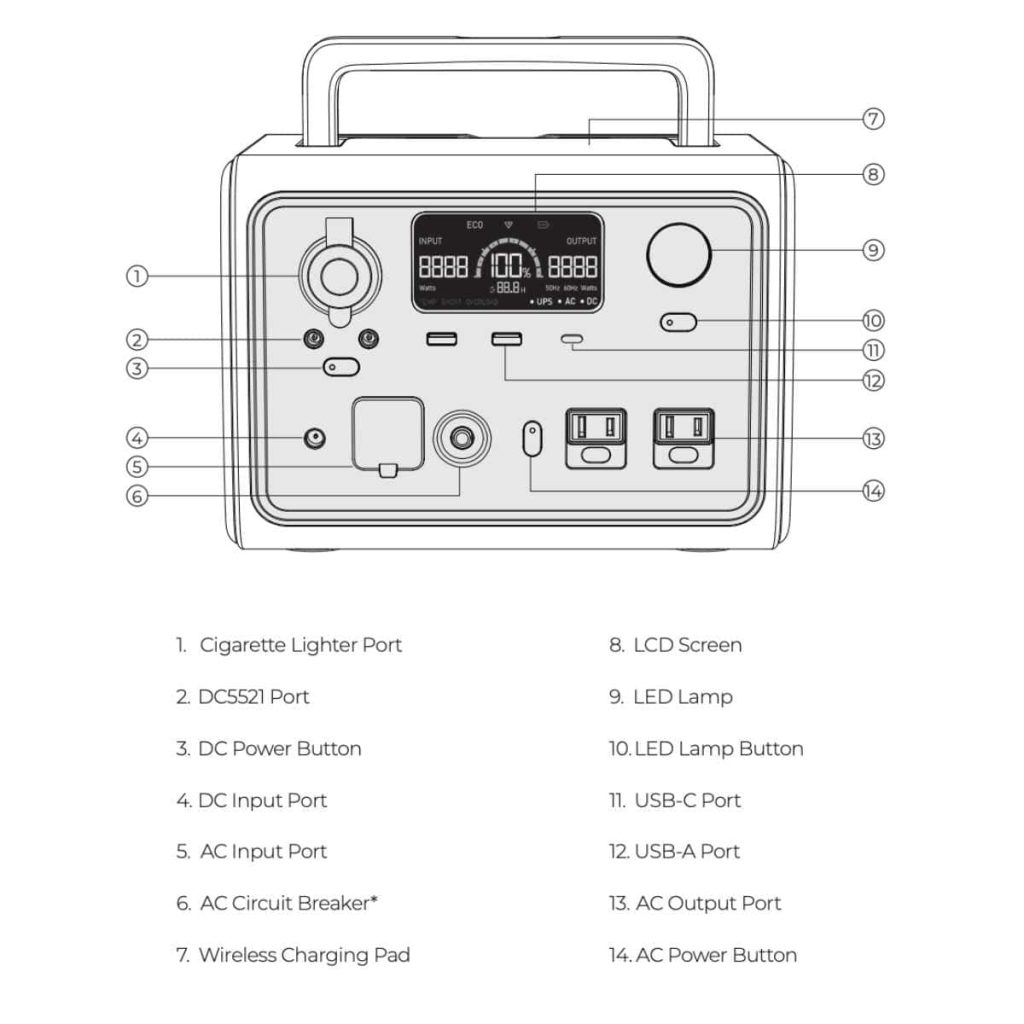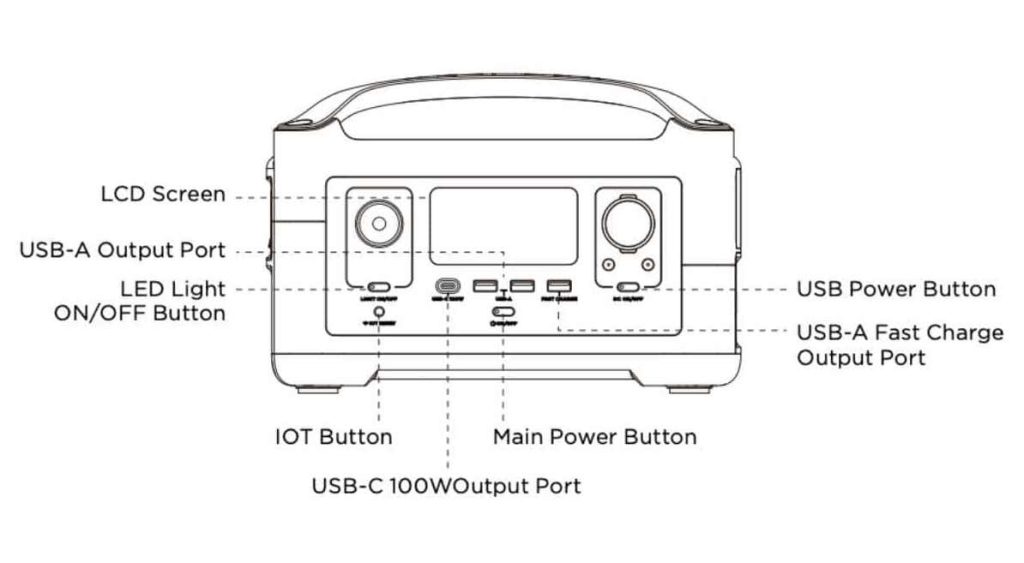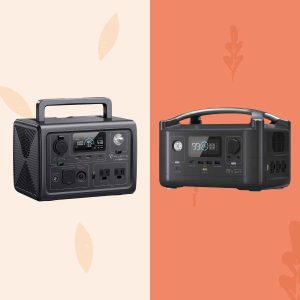If you’re a camper who needs a power source, an emergency prepper looking for backup power, or just someone interested in sustainable energy, the choice of power station is an important one.
But how do Bluetti and EcoFlow compare? Both pack impressive features in a small package, but they are different in some fundamental ways.
In this comparison, we’ll explore Bluetti EB3A vs EcoFlow River technical features – type of lithium batteries they use, storage capacities, charging speeds, outlets and ports, and bonus features like WiFi capability.
How do Bluetti EB3A vs EcoFlow River compare?
- [Tiny but Mighty] – With a 600W AC inverter, 268Wh…
- [Ultra-fast Charging] – No bulky power brick, a…
- [Harness the Power of Sun] – The built-in MPPT…
- [Reliable UPS] – EB3A instantly provides backup…
- [What You Get] – BLUETTI solar generator EB3A, AC…
- FAST RECHARGE IN 1 HOUR: EcoFlow’s X-Stream…
- COMPATIBLE WITH 80% OF HOME APPLIANCES: X-Boost…
- 3 x 600W AC OUTLETS, 288Wh CAPACITY: RIVER…
- MODULAR DESIGN FOR FLEXIBILITY: Double capacity…
- 24-MONTH SERVICE: EcoFlow provides 24×7 friendly…
Both the Bluetti EB3A vs EcoFlow River are lightweight, portable power stations well suited for camping and having backup emergency power when you need to charge devices like smartphones, LED lights and laptops.
Pros and Cons
Bluetti EB3A
- Pros: Long-lasting LiFePO4 battery, dual AC + solar charging option, UPS fallback, not waterproof, longer DC.
- Cons: Limited power capacity for high-demand appliances, only two AC outlets, longer recharge time when plugged into DC port.
EcoFlow River
- Pros: Powerful output, expandable battery, quick recharging, wide selections of outlets and ports, and clear LCD display.
- Cons: NMC battery life is limited to 500 cycles, no wireless charging option.
Battery Type
- The Bluetti EB3A features a premium LiFePO4 (Lithium Iron Phosphate) battery, which is known for its longevity, stability and lower risk of flammability.
- The EcoFlow River features an NMC (Nickel Manganese Cobalt) battery, which is known for having higher energy density, but a shorter lifespan.
Capacity
- The EcoFlow River has more battery capacity, starting at 288Wh and expandable to 576Wh.
- The Bluetti EB3A maxes out at a capacity around 268Wh.
- This means that the EcoFlow River has larger storage capacity than the Bluetti EB3A, and allows you to access more energy when you need it.
Output Power and Peak Surge
- The EcoFlow River has more output power, with 600W AC output and 1800W X-Boost surge. This is the River’s most impressive feature.
- In comparison, the Bluetti EB3A has 600W output and 1200W surge.
- This means the EcoFlow River is better than Bluetti in this scenario for running devices that need a lot of start-up power, like a blender or power tool.
Cycle Life (Lifespan)
The number of charge cycles represent the number of times the power station’s battery can be charged and discharged to 80% before it starts to lose capacity. The more charge cycles a power station has, the longer life span it has.
- The Bluetti EB3A has 3,000 more charge cycles. The Bluetti EB3A has a total of 3,000 charge cycles, in comparison to the EcoFlow River’s 500 charge cycles.


Outlets & Ports
| Port/Outlet Type | Bluetti EB3A | EcoFlow RIVER 2 |
|---|---|---|
| AC Outlets | 2 x 120V/5A AC outlets | 3 x AC outlets |
| DC Ports | 2 x DC 5521 (12V) + 1 x 12V/10A DC port | 3 x DC ports |
| USB-A Ports | 2 x 5V/3A USB-A ports | 2 x USB-A ports |
| USB-C Port (100W) | 1 x 100W USB-C port | 1 x USB-C PD (100W) |
| USB-C Fast Charge | N/A | 1 x USB-C Fast Charge |
| Wireless Charging Pad | 1 x Wireless Charging Pad (15W) | N/A |
- AC Outlets: The EcoFlow RIVER 2 offers 3 AC outlets, compared to 2 AC outlets on the Bluetti EB3A.
- DC Ports: Both have multiple DC ports, but the configurations vary slightly.
- USB-C Ports: Both models offer a 100W USB-C port, but the EcoFlow RIVER 2 has an additional USB-C Fast Charge port, giving it more versatility.
- Wireless Charging: Only the Bluetti EB3A includes a 15W wireless charging pad, making it more convenient for charging devices wirelessly.
Charging Time
Here is a comparison table of the real-world charging times for the Bluetti EB3A and EcoFlow RIVER 2 using different charging methods:
| Charging Method | Bluetti EB3A (268Wh) | EcoFlow RIVER 2 (256Wh) |
|---|---|---|
| AC Wall Outlet | 1 to 1.5 hours | 1 hour |
| Solar Charging | 3 to 4 hours (200W input, ideal conditions) | 3 to 6 hours (110W input, ideal conditions) |
| Car Charging (12V) | 6 to 7 hours | 4 to 5 hours |
| Car Charging (24V) | 3 to 4 hours | 3 to 4 hours |
| USB-C Charging | N/A | 4.5 to 5 hours (60W input) |
| Dual Charging (AC + Solar) | 1.5 to 2 hours | N/A |
- AC charging: The EcoFlow RIVER 2 charges slightly faster, reaching full charge in 1 hour. This is compared to 1 to 1.5 hours for the Bluetti EB3A.
- Bluetti users report that the EB3A reaches 80% charge in about 40-45 minutes, with the final 20% taking longer because of the battery management system.
- Solar charging: The Bluetti EB3A supports a higher solar input (200W) and charges slightly faster than the EcoFlow RIVER 2 (110W).
- Car charging: Both power stations are comparable when charging via 24V, but the RIVER 2 charges faster via 12V.
- USB-C charging: Only the EcoFlow RIVER 2 supports USB-C charging, with a charge time of 4.5 to 5 hours.
Connectivity
- Both the Bluetti and EcoFlow units can sync with a smartphone and be remotely managed using an APP.
- The Bluetti EB3A is Bluetooth enabled .
- The EcoFlow River is WiFi enabled and can receive updates to the power station, including features, optimizations, and security fixes.
Bonus Features
- The Bluetti EB3A has 20ms UPS capability and can act as an UPS (uninterrupted power supply) that automatically activates in a power outage. The UPS will transition within 20 milliseconds to power sensitive devices like medical equipment or refrigerators.
- The Bluetti EB3A has a wireless charging pad, which is convenient for charging things like smartphones. The EcoFlow River doesn’t have this.
Warranty:
- The warranty period is 2 years for the Bluetti EB3A and 5 years for the EcoFlow River.
Bluetti EB3A vs EcoFlow River Comparison Chart
| Features | Bluetti EB3A | EcoFlow River |
|---|---|---|
| Battery Capacity | 268.8Wh | 288Wh (Expandable to 576Wh) |
| AC Charging Time | 1.8 hours | 1.6 hours |
| Solar Charging Time | 2.8 to 3.3 hours | 1.6 to 3 hours |
| DC Charging Time | 5.3 to 5.8 hours (24V) or 10.1 to 10.6 hours (12V) | 3.5 hours |
| Weight and Portability | 10.1 lbs. (4.6 kg) | 11 lbs (5.5 kg) |
| AC Output | 600W (1200W Peak) | 600W (1800W X-Boost Peak) |
| Output Ports | 9 Outputs | 10 Outputs |
| – 2 x AC – 2 x USB-A – 1 x USB-C (100W) – 1 x DC Car Port (12V) – 2 x DC 5521 (12V) – 1 x Wireless Charging Pad (15W) | – 3 x AC – 3 x DC Ports – 2 x USB-A – 1 x USB Fast Charge – 1 x USB-C PD (100W) | |
| Lithium Battery Type | LiFePO4 | NMC |
| Charge Cycles | 2,500 | 500 |
| AC Input | 268W to 430W | 600W |
| Solar Input | 200W | 220W |
| DC Input | 200W | 12V |
| Bluetooth | Yes | No |
| WiFi | No | Yes |
| App Control | Yes | Yes |
| Warranty | 2 Years | 2 Years |
| Noise Level | Unknown | 60dB |
| What’s In the Box? | – Bluetti EB3A portable power station – AC adapter for charging – Car charger – Solar charging cable – User manual | – RIVER 288Wh portable power station – 1.5M AC Charging Cable – 1.5M Car Charging Cable – User manual |
Conclusion – Final Verdict
After thorough review, we choose the Bluetti EB3A as the better product. This decision is based on the LiFePO4 battery and larger number of charge cycles that the Bluetti EB3A provides in comparison to the EcoFlow River. While the EcoFlow River provides impressive surge power, the NMC lithium battery is its weakest feature and biggest limitation.
What are the similarities between Bluetti EB3A and EcoFlow River?
The Bluetti EB3A and EcoFlow River are similar in several ways, including starting capacity, AC recharging time, weight and portability, number of ports, APP control and solar input power.
How many charge cycles can Bluetti EB3A and EcoFlow River last?
The Bluetti EB3A has 2,500 charge cycles to 80%, while the EcoFlow River has 500 charge cycles. This means that the Bluetti EB3A battery has more charge / discharge capability and will ultimately have a longer lifespan.
What are the differences in battery capacity between Bluetti EB3A and EcoFlow River?
The Bluetti EB3A has battery capacity of 268.8Wh, while the EcoFlow River capacity starts at 288Wh. However, the EcoFlow River’s battery capacity can be expanded up to 576Wh, which means that it has larger overall storage capacity.
Useful Resources: Bluetti EB3A vs EcoFlow River
- Bluetti Official Website
- Jackery Official Store
- According to customer feedback, the Bluetti EB3A’s real-world tests delivered about 82.1% of its 268.8Wh capacity. This is a little below the usual expectation of 85% for similar models.
- Another concern cited by users is the occurrence of the EB3A overheating during charging when the battery is low, which could be a firmware issue.
EcoFlow River

The EcoFlow River portable power station delivers expandable capacity from 288Wh up to 576Wh, 1 hour recharge time when plugged into an AC outlet, and impressive 600W output and 1800W surge power.
Product Brand: EcoFlow
3
Pros
- [object Object]
- [object Object]
- [object Object]
- [object Object]
Cons
- [object Object]
- [object Object]
- [object Object]
Bluetti EB3A

The Bluetti EB3A is a power house in a small package. It features top-notch lithium-ion battery technology, significantly more charge cycles, and bonus features like wireless charging and UPS capability.
Product Brand: Bluetti
4.8
Pros
- Features a premium LiFePO4 battery
- Offers a diverse selection of ports, including a wireless charging pad and high-power 24V DC port
- Bluetooth and WiFi enabled
- Long lasting battery with 3,000 charge cycles
Cons
- Limited power capacity for high-demand appliances
- Only provides two AC outlets
- Recharge time is longer when plugged into a DC port
